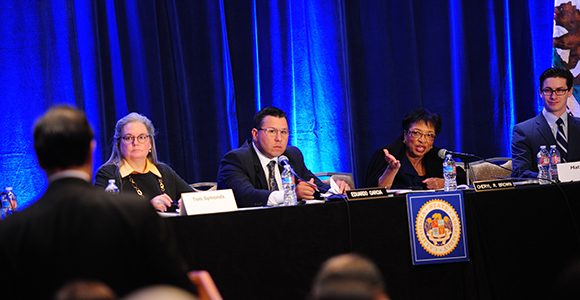
California State Assembly Chief Consultant Toni Symonds (left), Assemblymember Eduardo Garcia, Assemblymember Cheryl Brown at a hearing of the Committee on Jobs, Economic Development, and the Economy held in conjunction with the first day of the California Economic Summit. (Photo Credit: Violeta Vaqueiro)
The Roadmap to Shared Prosperity wound its way to Ontario today for first day of the 2015 California Economic Summit, as more than 400 civic and business leaders from across the state gathered to discuss how to move the state’s economy forward.
Co-presented by California Forward and the California Stewardship Network, this year’s Summit is focused on the “One Million Challenges,” which will guide action teams as they create ideas to produce over the next decade one million more skilled workers, one million more homes for low- and middle-income Californians, and one million more acre-feet of water each year. To that end, the seven Summit Action Teams met to identify problems and create plans on how their team will contribute to solving the challenges.
Even before the day officially began, economic development was the topic at the Assembly Committee of Jobs, Economic Development and the Economy (JEDE) hearing, held in conjunction with the Summit, featuring Assemblymembers Eduardo Garcia (D-Coachella) and Cheryl Brown (D-San Bernardino).
Ontario Mayor Paul Leon welcomed the committee with good economic news about his city: “Ontario has regained all the jobs lost in the recession.” And the economic outlook will also get better as the West Coast Distribution Center of QVC is scheduled to open next summer, along with the transfer of Ontario Airport from the City Los Angeles to local control. The city is also planning to add 10,000 new homes with the development of Ontario Ranch.
California Secretary of State Alex Padilla encouraged Summit participants in his welcoming address. “The work you’re doing is so important, and I’m glad it’s not just taking place in Sacramento or the Bay Area, but right here in the Inland Empire,” said Padilla.
In an interactive workgroup session, the Summit participants discussed how they would tackle each of the three challenges by identifying opportunities, the needs for cross-team collaboration and the top priority actions for collective impact. This afforded participants the opportunity to work with others from different areas and backgrounds on how to achieve the challenges. The results of the session were presented to the entire group.
Closing the day, a regional spotlight on the Inland Empire with a panel discussion was led by Inland Empire Economic Partnership president and CEO and Summit Steering Committee Co-Chair Paul Granillo. The panel included Sunne Wright McPeak of the California Emerging Technology Fund, Jim Gollub of the Capital Action Team, Julia Lopez of California Futures Foundation and John Husing of the Inland Empire Economic Partnership.
The panel discussed the region’s successes as well as its challenges, such as poverty and the digital divide, which brought McPeak to tears. “Talking about the two Californias really makes me cry,” said McPeak. “There’s more poverty today than when I graduated from college.”
But the Inland Empire is not unique to these challenges and, according to Gollub, the region can lead the way to finding solutions. “It’s a living laboratory for the future of the U.S. economy,” said Gollub, crediting Summit for advancing the conversation. “What’s happening here is building a model of the next economy.”
Tomorrow, Summit participants will learn more about the three challenges from expert panels. Then, attendees will engage in breakout sessions and make commitments toward solving the challenges. Speakers slated for tomorrow will include University of California President Janet Napolitano, California State University Chancellor Timothy White, Lt. Governor Gavin Newson, State Controller Betty Yee and State Treasurer John Chiang.

